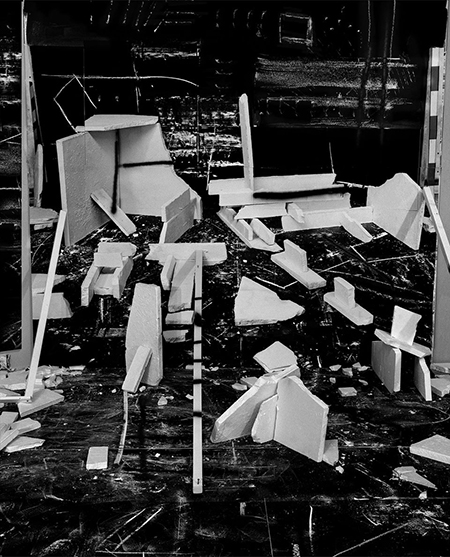
Continuing through April 4, 2015
There has always been something perverse in the “ruins porn” panoramas of Yves Marchand and Romain Meffre, Camilo José Vergara and their many imitators. They, and by proxy we viewers, simultaneously weep and lick our chops at the heart-rending but eye-piquing specter of what is euphemistically called “urban decay,” which is to say, neighborhoods so wrecked by poverty and dereliction as to no longer be inhabitable. These tableaux activate our sense of the apocalyptic, of the scorched earth beyond redemption that lurks in the back of our minds as a grim possibility for a near or distant future in which this whole civilization thing does not work out.
Despite this rich symbolic terrain for artists circa 2015 to simply ape, Marchand & Co.’s method is not a path to credibility. Enter Rodrigo Valenzuela, a native of Chile who is now based in Seattle, created the current body of work for “Hedonic Reversal" in Houston, Texas, where he is presently a resident at the Glassell School of Art. He notably reverses the trope of ruins porn by reimagining it as a meta-exercise. He illuminates not so much the subject of our voyeurism as the process of looking itself. Using white-painted wood, drywall, plaster, foam, and chalk, he constructed faux ruins (actually just a panoply of ragtag sculptures placed in architectonic schemata), then photographed them with a medium-format film camera and printed them digitally. In some of the exhibition’s nine prints, the artist re-installed details from the finished images in his studio, tacking them to a wall to create a false perspective. Subsequently he rephotographed the altered room, which now took on an off-kilter, composited sense of illusionism, compounded by selective PhotoShopping. Formally, the prints benefit from their sumptuous contrast between obsidian blacks and Dover-cliff whites, as well as from their destabilized compositions. In aggregate, however, they come across a bit one-note, owing mostly to the homogeneity of the constructed “ruins.”
On the gallery’s east wall, Valenzuela’s short film “Maria TV” begins with a scene from the Chilean soap opera “Ángel malo” (“Bad Angel”), in which a woman of low socioeconomic standing reluctantly agrees to give up her baby to its higher-born father. Following this clip, dozens of working-class women (not actresses) walk, talk, and stretch their arms before a neutral background, recounting in voiceover the tribulations they’ve faced as immigrants and single mothers. Next they reenact the soap-opera clip, inhabiting the part of the woman whose child is being repossessed. (Incidentally but probably not coincidentally, they are better actresses than the original professional.) To connect this video to the faux-ruins prints is a bit of a stretch, but the common thread seems to be the artist’s commitment to empowering disenfranchised voices via aesthetic visibility.
Valenzuela’s conceit is agreeably ambiguous, for who is to say that finding straightforward beauty in ruins — and buying into romanticized, reductivist portrayals of women — are any less egregious than transliterating those same proclivities into critiques ready-made for residencies, high-minded artist statements, and prestigious gallery shows? Happily, the work’s formal qualities — the trompe l’oeil effects in the prints and the peripatetic pastiche of the video — afford “Hedonic Reversal” a life of its own as pure visual opulence, with viewers at liberty to make their own sociopolitical inferences.
